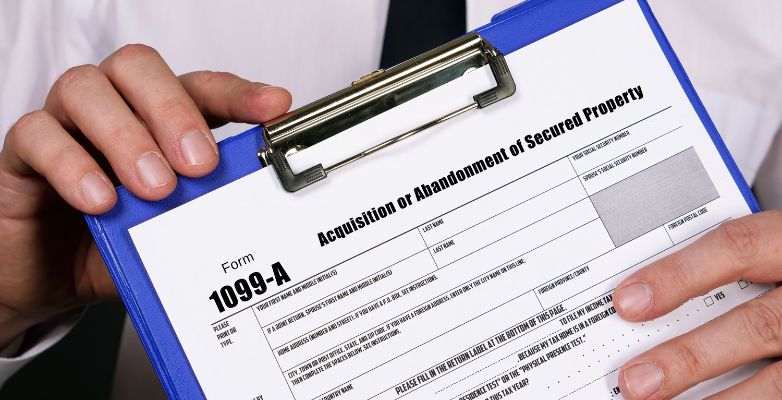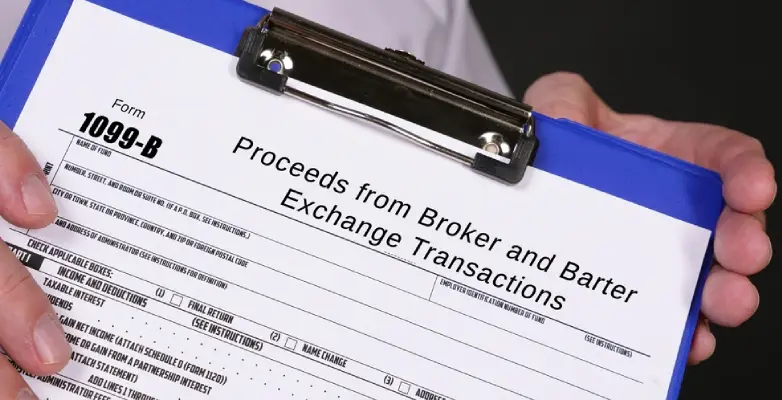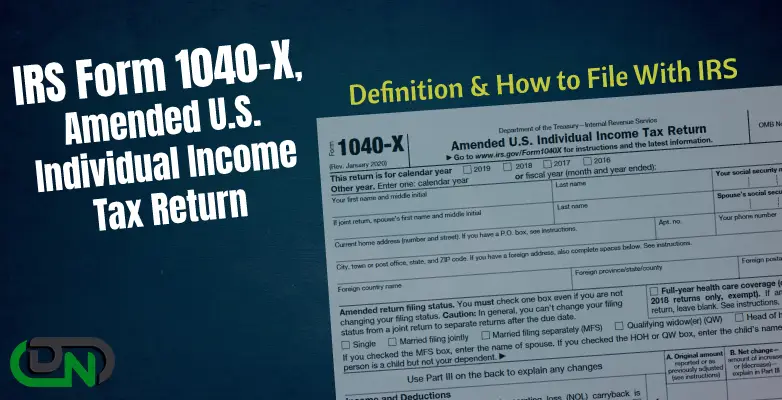Tax forms can be difficult and getting them right is important. The IRS is all about collecting the correct amount of income tax but it can be complex especially when various sources of income are involved.
While dealing with taxes it’s important to have information about the various forms involved. One such document is the IRS Form 1099-A which is used to report the acquisition or abandonment of secured property.
Form 1099-A is typically filled by banks, lenders, financial institutions, or other entities that have a security interest in a property.
If you’ve recently experienced a foreclosure, property repossession, or voluntarily abandoned secured property, understanding the basics of Form 1099-A is crucial for navigating the associated tax implications. In this article, we’ll delve into the specifics of Form 1099-A and shed light on its importance.
Table of Content
- 1 Purpose of Form 1099-A
- 2 The IRS Provides 21 Types of 1099 Forms, Each Serving a Specific Purpose
- 3 Benefits of Form 1099-A
- 4 Who Is Eligible To File Form 1099-A?
- 5 How To Complete Form 1099-A: A Step-by-Step Guide
- 5.1 Step 1: Gather Necessary Information
- 5.2 Step 2: Obtain the Official Form
- 5.3 Step 3: Provide Payer and Recipient Information
- 5.4 Step 4: Complete Property Information
- 5.5 Step 5: Enter the Dates
- 5.6 Step 6: Report the Fair Market Value
- 5.7 Step 7: Provide the Loan Information
- 5.8 Step 8: Review and Certify
- 5.9 Step 9: Distribute Copies
- 5.10 Step 10: Submit to the IRS
- 6 Common Mistakes to Avoid When Filing Form 1099-A
- 7 What Are The 6 Boxes of Form 1099-A?
- 8 When Does Debt Get Canceled?
- 9 Download IRS Form 1099 A
- 10 Conclusion
- 11 Frequently Asked Questions
Purpose of Form 1099-A
This form comes into play when lenders or financial institutions take possession of a property due to foreclosure, repossession, or any such similar circumstances. It’s also used when a borrower voluntarily abandons the property, signifying the relinquishment of ownership and possession of the secured property.
The form provides vital information about the property, such as its fair market value (FMV) at the time of acquisition or abandonment, the remaining loan balance, and details about the borrower. The IRS uses this information to determine any potential taxable gain or loss resulting from the transaction.
For borrowers, receiving Form 1099-A means potential tax implications. Borrowers should seek guidance from a tax professional to understand how the acquisition or abandonment of secured property may impact their tax situation. They might need to report the transaction on their tax return and account for any applicable gains or losses.
It’s important to distinguish Form 1099-A from Form 1099-C which is used to report cancelled debts. Form 1099-C is issued when a lender forgives or cancels a debt. This results in taxable income for the borrower. If a taxpayer receives both forms for the same property, they should ensure they reconcile the information correctly and report it on their tax return accordingly.
Rather than one single form, the Form 1099 represents a collection of IRS forms used for different types of income. You’re probably familiar with the W-2, which employees receive from their employers to report their income. The form 1099 on the other hand is issued by companies, organizations, or individuals who don’t have the recipient. Contractors, freelancers, and self-employed individuals typically receive these forms, but they’re not limited to just work-related income.
The IRS Provides 21 Types of 1099 Forms, Each Serving a Specific Purpose
As per March 2023, here’s an overview:
- 1099-A: For the acquisition or abandonment of secured property, often related to unpaid debts.
- 1099-B: Used for proceeds from broker and barter exchange transactions, such as stock or commodity sales.
- 1099-C: If you’ve had debt cancellation of $600 or more.
- 1099-CAP: When you’re a shareholder in a company undergoing changes in control or capital structure.
- 1099-DIV: Reporting dividends and other investment distributions.
- 1099-G: Covers certain government payments, including unemployment insurance, tax refunds, and agricultural subsidies.
- 1099-H: Used for Health Coverage Tax Credit (HCTC) advance payments.
- 1099-INT: For reporting interest income of over $10 from financial institutions.
- 1099-K: Tracks payment card and third-party network transactions (note: minimum thresholds may vary).
- 1099-LS: Required for reportable life insurance sales.
- 1099-LTC: Used for long-term care and accelerated death benefits.
- 1099-MISC: This is for miscellaneous income and includes various payments not covered by other 1099 forms.
- 1099-NEC: Tracks nonemployee compensation, often paid to contractors and freelancers.
- 1099-OID: Used for original issue discount on certain debts and bonds.
- 1099-PATR: For reporting taxable distributions received from cooperatives.
- 1099-Q: Used for payments from qualified education programs (under Sections 529 and 530).
- 1099-QA: This form is for distributions from ABLE accounts.
- 1099-R: For distributions from pensions, annuities, retirement plans, IRAs, and more.
- 1099-S: Tracks proceeds from real estate transactions.
- 1099-SA: Used for distributions from health savings accounts and related accounts.
- 1099-SB: This form is for the seller’s investment in a life insurance contract, particularly relevant when selling a policy or transferring it to a non-U.S. citizen.
These forms help the IRS keep tabs on different types of income, and the type you receive depends on your financial activities throughout the year. Ensure to review the specific requirements for each form while filing your taxes.
Benefits of Form 1099-A
When it is not directly benefiting the recipient Form 1099-A serves several important purposes and carries implications for both lenders and borrowers. Here are key advantages and considerations associated with Form 1099-A:
- Tax Reporting: Form 1099-A provides essential information for reporting the acquisition or abandonment of secured property for tax purposes. It ensures that lenders, borrowers, and the IRS can accurately document the transaction and comply with tax regulations.
- Acquisition of Property: For the lenders Form 1099-A serves as a record of property acquisition when a borrower defaults on a loan. It offers details like the borrower’s name, address, and taxpayer identification number (TIN), facilitating transaction tracking and subsequent tax reporting.
- Abandonment of Property: In cases where a borrower abandons secured property, Form 1099-A enables lenders to report the abandonment and potentially claim a tax deduction or loss on the property’s disposition. This can be advantageous for lenders, helping offset income or reduce taxable gains.
- Basis and Fair Market Value: Form 1099-A discloses the fair market value (FMV) of the property at the time of acquisition or abandonment, along with the outstanding principal loan balance. This information is crucial for determining the lender’s basis in the property and calculating potential gains or losses in future sales or dispositions.
- Potential Tax Consequences: For borrowers receiving Form 1099-A may have tax implications. The acquisition or abandonment of secured property can result in taxable income or a loss that must be reported on the borrower’s tax return. It’s essential for borrowers to consult with a tax professional to grasp the potential tax consequences of the transaction.
- Documentation and Record-Keeping: Form 1099-A offers an official record of the acquisition or abandonment of secured property. It aids both lenders and borrowers in maintaining accurate records for future reference, potential legal matters, or audits.
Who Is Eligible To File Form 1099-A?
Form 1099-A is known as the Acquisition or Abandonment of Secured Property and it is typically filed by specific organizations and individuals. Here’s a breakdown of who may be eligible to file Form 1099-A:
- Lenders: Financial institutions such as banks, credit unions, and organizations involved in lending money with a security interest in the property are commonly responsible for filing Form 1099-A.
- Mortgage Lenders: When a mortgage lender forecloses on a property or accepts a deed-in-lieu of foreclosure, they may need to file Form 1099-A to report the acquisition or abandonment of the property.
- Government Entities: Government agencies that acquire or abandon secured property might also be required to file Form 1099-A.
It’s important to note that individual taxpayers usually don’t file Form 1099-A unless they are engaged in the lending business or are a government entity responsible for secured property’s acquisition or abandonment.
How To Complete Form 1099-A: A Step-by-Step Guide
Properly completing Form 1099-A demands careful attention to detail. Here’s a step-by-step guide to help you navigate the process:
Step 1: Gather Necessary Information
Before beginning to fill out the form, ensure you have all the pertinent information at hand including:
- Name, address, and taxpayer identification number (TIN) of the lender or financial institution.
- Name, address, and TIN of the borrower or debtor.
- Property description that was acquired or abandoned.
- Dates of acquisition or abandonment.
- Fair market value (FMV) of the property at the time of acquisition or abandonment.
- Outstanding principal balance of the loan or debt.
Step 2: Obtain the Official Form
Visit the IRS website and download Form 1099-A. You can locate the form through the website’s search feature or in the “Forms and Publications” section.
Step 3: Provide Payer and Recipient Information
In the top left section of Form 1099-A, input the payer’s name, address, and TIN, which is typically the lender or financial institution. On the right side, insert the recipient’s name, address, and TIN, generally the borrower or debtor.
Step 4: Complete Property Information
In Part I of the form, furnish particulars about the acquired or abandoned property, including the complete address and description. Indicate the property’s status (acquired or abandoned) by checking the relevant box.
Step 5: Enter the Dates
In Part I specify the date of acquisition or abandonment in the MM/DD/YYYY format.
Step 6: Report the Fair Market Value
Part II reports the property’s fair market value (FMV) at the time of acquisition or abandonment, reflecting its current condition.
Step 7: Provide the Loan Information
In Part III disclose the outstanding principal balance of the loan or debt at the time of acquisition or abandonment. This figure should include the unpaid principal, accrued interest, and other charges.
Step 8: Review and Certify
Thoroughly review all the entered information for accuracy. After that, sign and date the form in the appropriate spaces. If you’re completing the form on behalf of a business, include the business name and your title.
Step 9: Distribute Copies
Create copies of Form 1099-A for your records, the recipient, and the IRS. Furnish the recipient with Copy B, and file Copy A along with Form 1096, which serves as a transmittal form for all submitted 1099 forms. Send Copy A to the IRS by it’s due date.
Step 10: Submit to the IRS
Mail Copy A of Form 1099-A accompanied by Form 1096, to the appropriate IRS address. The precise address can be found in the instructions for Form 1096. Ensure that you meet the filing deadline, which is typically by the end of February for paper filings or the end of March for electronic submissions.
Common Mistakes to Avoid When Filing Form 1099-A
When dealing with Form 1099-A you should avoid these common mistakes:
- Incorrect or Missing TINs: Ensure that both the transferor’s and transferee’s taxpayer identification numbers (TINs) are accurately mentioned and verified to prevent discrepancies.
- Incomplete Information: Provide comprehensive details about the secured property’s acquisition or abandonment, including dates, fair market value, and outstanding loan balances.
- Property Description: Include a clear and specific property description, covering address, type, and other relevant details.
- Filing Timing: Stick to the filing deadline; missing it or not filing the form can lead to penalties.
- Recipient Copy: Furnish a copy of Form 1099-A to the recipient (transferor) after filing. Failing to do so may result in penalties.
- Calculation Accuracy: Double-check calculations for fair market value, loan balances, and other figures to avoid discrepancies.
- Correct Form: Make sure you’re using the appropriate form for reporting the acquisition or abandonment of secured property which is Form 1099-A.
- Record-Keeping: Maintain accurate records of the reported information and supporting documents for future inquiries or audits.
What Are The 6 Boxes of Form 1099-A?
Form 1099-A comprises six boxes on the right side, each serving a specific purpose for reporting details about the secured property’s acquisition or abandonment:
- Box 1: Records the borrower’s name, address, and taxpayer identification number (TIN).
- Box 2: Documents the date when the lender acquired the property.
- Box 3: Reports the fair market value of the property at the acquisition time.
- Box 4: Notifies of any outstanding mortgage or debt associated with the property upon acquisition.
- Box 5: Accounts for any cash or property received by the lender related to the property’s acquisition.
- Box 6: Provides space for additional details regarding the property’s acquisition or abandonment.
When Does Debt Get Canceled?
A debt is considered canceled when a specific event occurs. On the date of actual discharge, you should decide to file Form 1099-C in the year of cancellation. These identifiable events can include:
- A discharge in bankruptcy under Title 11 of the U.S. Code (not required to be reported in certain cases).
- A cancellation or extinguishment that renders the debt unenforceable through legal proceedings like receivership, foreclosure, or similar federal non-bankruptcy or state court actions.
- The debt becomes unenforceable due to the expiration of the statute of limitations for debt collection, or when the time for filing a claim or initiating a deficiency judgment proceeding expires.
- The creditor opts for foreclosure remedies that legally eliminate their right to collect the debt. This typically applies to mortgage lenders in cases of “power of sale” execution.
- A cancellation or extinguishment makes the debt unenforceable through probate or similar procedures.
- A discharge of indebtedness resulting from an agreement between the creditor and the debtor to cancel the debt for less than the full amount (e.g., in short sales).
- The creditor discontinues collection efforts and forgives the debt based on an established policy or written agreement.
- Each of these scenarios has its own unique code (A to H) to identify the event when reporting it.
Download IRS Form 1099 A
Conclusion
In conclusion, IRS Form 1099-A is a crucial document used to report the acquisition or abandonment of secured property. Lenders, financial institutions, and government entities play a pivotal role in its filing. Borrowers should be aware of the potential tax implications and consult a tax professional for guidance. Filing deadlines are important and extensions may be requested if necessary. For any upcoming questions or concerns, don’t hesitate to reach out to our team of Experts for assistance with Form 1099-A who are always available to help you out 24×7.
Frequently Asked Questions
What is IRS Form 1099-A?
IRS Form 1099-A, titled “Acquisition or Abandonment of Secured Property,” is a tax form used to report the acquisition or abandonment of secured property. It’s filed by lenders, financial institutions, or entities that hold a security interest in a property when foreclosure, repossession, or abandonment occurs.
Who needs to file Form 1099-A?
Form 1099-A is typically filed by lenders, mortgage lenders, and government entities that have taken over secured property due to foreclosure, repossession, or abandonment. Individual taxpayers usually don’t file this form unless they are in the lending business or a government entity responsible for property acquisition or abandonment.
What information does Form 1099-A include?
Form 1099-A requires details about the property, including its fair market value at the time of acquisition or abandonment, the outstanding loan balance, and information about the borrower. This information helps the IRS determine potential taxable gains or losses.
How does Form 1099-A affect borrowers?
For borrowers, receiving Form 1099-A may have tax implications. They should consult a tax professional to understand how the acquisition or abandonment of secured property could impact their tax situation. Borrowers may need to report the transaction on their tax return and account for any applicable gain or loss.
What’s the difference between Form 1099-A and Form 1099-C?
Form 1099-A is used to report the acquisition or abandonment of secured property, while Form 1099-C is used to report canceled debts. Form 1099-C is issued when a lender forgives or cancels a debt, potentially resulting in taxable income for the borrower. Both forms may be received for the same property, and taxpayers may need to reconcile the information on their tax returns.
When should I file Form 1099-A?
The general deadline for filing Form 1099-A is January 31 of the year following the calendar year in which the acquisition or abandonment occurred. If you miss the deadline, you can request an extension by filing Form 8809. However, an extension to file doesn’t extend the deadline for paying any taxes owed.




